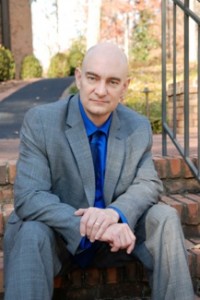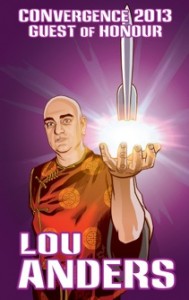interview by Carl Slaughter
 Lou Anders is the Hugo Award winning editorial director of the SF&F imprint Pyr Books, a Chesley Award winning art director, and the editor of nine anthologies. He has also been nominated for six additional Hugo Awards, five additional Chesley Awards, as well as the PKD, Locus, Shirley Jackson, and three World Fantasy Awards. His first novel, Frostborn, book one in a three-book middle grade fantasy adventure series called Thrones and Bones, will be published in August 2014 by Random House’s Crown Books for Young Readers.
Lou Anders is the Hugo Award winning editorial director of the SF&F imprint Pyr Books, a Chesley Award winning art director, and the editor of nine anthologies. He has also been nominated for six additional Hugo Awards, five additional Chesley Awards, as well as the PKD, Locus, Shirley Jackson, and three World Fantasy Awards. His first novel, Frostborn, book one in a three-book middle grade fantasy adventure series called Thrones and Bones, will be published in August 2014 by Random House’s Crown Books for Young Readers.
ABOUT YOU
CARL SLAUGHTER: You’ve done stage, scriptwriting, magazine, journalism, ebook. How did each of these fields prepare you to be editorial director of a speculative fiction book imprint?
LOU ANDERS: In one form or another, I’ve been working in the science fiction and fantasy genre since the early 90s. If we carve off my (perhaps dubious) stage work, then I’ve been a professional in science fiction and fantasy entertainment since 1995, and I was in the ebook space in 2000 before there was such a thing! I think the diversity of my professional experience gives me well-rounded perspective on media, while keeping the focus on genre.
ABOUT YOU AND PYR:
 CS: There were several speculative fiction imprints at the time Pyr was launched. Tor, Del Rey, Ace, DAW, Baen, Why another imprint? What void have you been filling? How is Pyr distinct from other imprints?
CS: There were several speculative fiction imprints at the time Pyr was launched. Tor, Del Rey, Ace, DAW, Baen, Why another imprint? What void have you been filling? How is Pyr distinct from other imprints?
LA: My parent company, Prometheus Books, wanted to get into fiction and chose science fiction as an appropriate niche for a company founded on principles of humanism and science. When we were starting out, we very quickly dismissed the idea of specializing in a particular subgenre in favor of trying to provide high quality science fiction and fantasy in what Asimov’s once described as genre being “pitched down the middle of the field” but written at a higher level of prose quality. About three years into our run, we began to hear from the chain buyers and distributors that we had the “most consistent quality” of any publisher as well as the consistently best looking covers. So, I’d say that we are trying to be SFF “dialed to eleven.” One fan once told us that while they don’t always like every Pyr title, they know that every Pyr book will be an engrossing read, well executed.
CS: Pyr was launched in 2005. You were nominated for a Hugo for best editor in 2007 and have been nominated every year since. How did you come on so strong so early and how did you maintain that momentum?
LA: There were a lot of factors that came together at the right time around our debut. We’re very fortunate to have connected with the readership so strongly, and I’m grateful for all those nominations. All we can do is continue to do our best and be glad that people appreciate that.
CS: Imagine you’re assigned to write a three paragraph entry about Pyr for the next encyclopedia of speculative fiction. What do you say? Give us a peekat those three paragraphs.
LA: I can’t answer this. It’s up to the field to define who we are. We can only offer the best we can. How the readership responds to that offer isn’t up to us. So far they’ve liked what we do and we’ll work to ensure that continues as best we can.
CS: You’ve also been nominated several times for anthology editor. Give us a thumbnail sketch of your vision for anthologies, past, present, and future.
LA: Well, I don’t know if I’m going to do any more anthologies in the future. I’ve turned my attention to my own fiction, and given the copious amounts of free time I don’t have, any and all snatches of personal time I have that is not claimed by my family goes into my own creations. But when I did anthologies, my goal was to never simply present reprint collections of themed stories, but to ask questions of where I thought the genre was, where it was going next, and where it should be. Each of my nine anthologies are attempts to engage the dialogue of speculative fiction in a moment, whether that was my frustrations with the limits of post-cyberpunk fiction in Live Without a Net, or my desire to explore the intersection of sword and sorcery values with modern, “realistic” fantasy in Swords & Dark Magic (co-edited with Jonathan Strahan). Every anthology is a question put to the field and hopefully a collection of answers.
CS: You’ve won the Chesley Award for Best Art Direcotr. I confess,I’m not an art person. I confess further that most sci fi / fantasy art strikes me as, well, bizarre. Explain the why and how of cover art for the decidedly non-arts people.
LA: Well that makes me sad to hear. Our field is unique in that it has over a century of cooperation between visual artists and wordsmiths. It’s one of the most exciting and distinctive things about the SFF field. But you have to understand that a cover’s first function is to attract the attention of the one guy at Barnes and Noble who buys all genre books for the entire chain. Beyond that, it’s to get the distribution sales force excited about a book. Then it’s to catch the casual browser’s attention, to close that deal in the nanosecond you have when someone glances at a title before his or her eye slides on to the next one. Think of covers like flowers, signaling with their colors to the right insects they need for pollination. You have to match the right flower to the right bug , the right book to the right reader.
ABOUT PYR
CS: What percentage of fantasy versus science fiction versus, shall we say, works which defy category, have you published? How much hard science, space opera, alternate history, steam punk, horror, etc. How many serials, how many anthologies, how many reprints?
LA: We publish a great deal of epic fantasy and sword and sorcery fiction, a great deal of steampunk, some space opera and military science fiction. We don’t publish horror and very little of what you’d call slipstream. Our Vampire Empire trilogy may defy categorization as you say , being an alternate history, pulp fiction, paranormal romance, steampunk, vampire epic , but that’s not the same thing as the more literary “new wave fabulism” that I think you mean. I should point out that these days we publish a LOT more fantasy than science fiction, though when we do SF, we do it well (ahem, Ian McDonald). We also have some very hard hitting work coming out from Joel Shepherd.
CS: Is there a market niche you’re struggling to meet? Is there one with a glut of manuscripts?
LA: We are trying to publish the best stories we can and serve a wide variety of readers. That being said, the urban fantasy genre is certainly glutted and probably in retraction.
CS: Which subgenres are you drawn to and which subgenres do you avoid?
LA: I have a sweet spot for sword and sorcery, and for the modern fantasy epic.
CS: With fantasy, do you prefer original characters or classic creatures – dragon, vampire, werewolf, witch, ghost, mermaid.
LA: This depends entirely on execution. There’s been a backlash against classic fantasy characters like elves and dwarves for a while now. In the wake of George RR Martin’s success we’ve seen a lot of “humans only” fantasy. I think we’re actually due to come back from this.
CS: Vampires are all the rage. Sexy kickass heroines have been in vogue for some time. Alien invasion and alien encounter are staples. Do you go with the flow or do you resist the flow?
LA: Read Mark Hodder’s A Red Sun Also Rises and tell me what you think.
CS: Hypothetical question: You have 2 manuscripts on your desk, one sci fi, one fantasy, both by the same author, and you can publish only one. Which one, or does it just all depend? If the latter, depends on what?
LA: I publish the one that has me jumping out of my chair in excitement. Period. If I can’t get excited about it, how can I get you excited about it? That being said, you never have two manuscripts from the same author.
CS: Who do you have doing hard science, how do they approach hard science, and how is that approach distinguished from what else is on the market?
LA: Hard science fiction is very much a niche interest right now. When I publish hard science fiction, I lean away from transparent prose in favor of the literary end of that spectrum. I’d say all our hard SF is “literary award caliber.” I think our awards track record bears this out!
ABOUT ASPIRING WRITERS
CS: True or false: Every editor is eager to find new authors. It’s virtually impossible to sell a first novel manuscript without working your way up the short story magazine food chain til you’ve been published in SFWA markets a few times. A novel by a veteran sell better and are first novel sales sluggish, or is that also conventional wisdom? A big name author can sell you on a story with strictly the premise, but a rookie has to submit a full fledged outline.
LA: You have a number of false assumptions here. Plenty of first time novelists have never written/sold short stories. The two forms are very different and a lot of people find they excel at one and not the other. I myself am in that camp. I’ve only written a handful of short stories, none appearing in pro markets, and I’ve just sold a children’s book to Random House. And Pyr has published a lot of debut and new authors. Also, a novel by a veteran author may be constrained by his/her previous sales record, whereas a new author is an unknown quality, and that can be attractive. That being said, a “rookie” has to submit a full fledged NOVEL, not outline. No unproven writer can sell anything but a complete, polished manuscript. And most of my established authors are still giving me very, very detailed outlines if not whole manuscripts. (Ian McDonald’s outlines can run to around 60 pages.) Mike Resnick did sell me his Weird West quartet of steampunk Doc Holiday novels on a premise, but in that case it was because I called him up and said “Mike, how would you like to write Weird Western?”
CS: Hypothetical question: You have 2 manuscripts on your desk, one by an established author, one by an unestablished author, and you can publish only one. Which one, or does it just all depend? If the latter, depends on what?
LA: You seem to be implying that I’ve got this checklist of criteria or quota that I’m looking at when I select a manuscript. Need suburban werewolf space opera. Must fill niche. I publish the manuscript that has me jumping out of my chair. The one that has me gasping for breath. The one that has my heart racing. I publish the books I love. If a book is “interesting” but I can put it down, I pass. There is a great line in the film Ronin in which Robert De Niro says, “If there’s any doubt, there’s no doubt.” That’s my mandate when acquiring novels.
CS: Advice to an aspiring writer who is already working on a novel?
LA: Is this your first novel? Expect to write several more before you produce one of professional quality. Don’t be discouraged. Write a novel. Finish it. Write another. Writing is like any other profession. It takes long hours of hard work and practice to get good at it. I’m a big believer in Malcolm Gladwell’s
10,000 hours rule, the notion that 10,000 hours is the average time it takes to master a pursuit. I wouldn’t let a brain surgeon operate on me if he told me
he’d never been to med school but was “pretty sure he could perform a good operation.” So why would someone believe they could pound on a keyboard for the
very first time and produce a masterpiece? Write, write, write. That being said, it’s not my job to help aspiring writers. It’s my job to select the best
manuscripts I can possibly find for my publisher from the pool of those who have already mastered the craft. I’m serving the reader, not the writer. The
competition is fierce. There are much better ways to make a living. If anything can discourage you, you should listen to it and quit. If you can’t quit, you
might make it.
CS: Advice to an aspiring writer who is considering writing a novel?
LA: You have along road ahead of you. Get started. Or don’t.
 Carl Slaughter is a man of the world. For the last decade, he has traveled the globe as an ESL teacher in 17 countries on 3 continents, collecting souvenir paintings from China, Korea, Thailand, Vietnam, and Egypt, as well as dresses from Egypt, and masks from Kenya, along the way. He spends a ridiculous amount of time and an alarming amount of money in bookstores. He has a large ESL book review website, an exhaustive FAQ about teaching English in China, and a collection of 75 English language newspapers from 15 countries.
Carl Slaughter is a man of the world. For the last decade, he has traveled the globe as an ESL teacher in 17 countries on 3 continents, collecting souvenir paintings from China, Korea, Thailand, Vietnam, and Egypt, as well as dresses from Egypt, and masks from Kenya, along the way. He spends a ridiculous amount of time and an alarming amount of money in bookstores. He has a large ESL book review website, an exhaustive FAQ about teaching English in China, and a collection of 75 English language newspapers from 15 countries.
His training is in journalism, and he has an essay on culture printed in the Korea Times and Beijing Review. He has two science fiction novels in the works and is deep into research for an environmental short story project.
Carl currently teaches in China where electricity is an inconsistent commodity.
